04 When I Was A Cowboy, Ledbelly cover by Matt Cartsonis
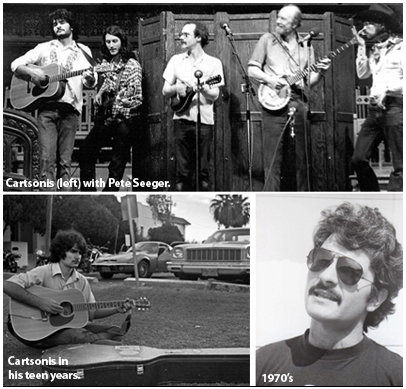 Sin City Spotlight:
Sin City Spotlight:
Matt Cartsonis
Sin City’s Sideman
by Courtney Sudbrink, Editor
Whether he’s pickin’ Pete Seeger’s banjo, singing with Emmylou Harris or rescuing a boatload of Cuban refugees, Matt Cartsonis always manages to fly under the radar. Quite possibly the music industry’s equivalent to Dean Moriarty (the unlikely hero and exceptionally cool sidekick in Jack Kerouac’s On the Road), Matt Cartsonis is a character whose legendary tales are so far from the realm of normal experience, one hell of a book could be written about his adventures and misadventures across the vast landscape of American music.
When Bob Dylan, Brian Wilson, Glen Campbell, Warren Zevon, Lucinda Williams and Steve Martin are just some of the people a musician has played with, he must be good at what he does. And nothing could be truer than in the case of Matt Carsonis. The last of a rare breed, he is one of the few musicians in Los Angeles, who finds himself most at home in the background, accompanying others’ greatness.
A true “musician’s musician,” this laid-back and humble picker is never far off in the shadows of whatever legendary artist he finds himself working with. Though his name may not be known by most, when it comes to the artists who’ve shaped our musical roots, Matt Cartsonis has certainly played an important supporting role. But what sets him apart, is not only the unique ability to play anything at any given moment, but also his genuine good nature and humility.
An Arizona native, Cartsonis began his immersion into Americana at the age of four, when his mother gave him a copy of Woody Guthrie’s Songs To Grow on For Mother and Child, an album he cites as the foundation of his musical education.  Though his exposure to acoustic standards at such a young age may helped carve Cartsonis’ path in life, it seems, like Guthrie, he was born to play roots music and destined for a life filled with never ending stories.
Though his exposure to acoustic standards at such a young age may helped carve Cartsonis’ path in life, it seems, like Guthrie, he was born to play roots music and destined for a life filled with never ending stories.
From the time he was a teenager, Cartsonis’ guitar has never been far from his reach. At the age of sixteen, he began his professional career by sitting in with Bluegrass bands all over the country. It was at this time, that the young folkie would first encounter the Seeger family, who in many ways, not only showed him the ropes, but also played an integral role in Cartsonis’ later development, which would ultimately help secure him a notable spot in the world of traditional music.
“Mike Seeger was the first (in my world) ‘famous’ person I ever met. I saw him when I was sixteen up in San Francisco. At the time I was playing in an old time string band and the New Lost City Ramblers were there,” recalls Cartsonis.
Of course, this would only be the first of several coincidences that would bring Cartsonis in close company with Folk Music’s First Family. But before his next meeting with the Seegers, the then twenty year old musician, decided to leave Arizona and travel to Key West, in hopes of discovering his way in life. This decision that not only led him to his first correspondence with Patriarch, Pete Seeger, also put him in the midst of a Hemingway style adventure between the United States ‘Southern Most Point’ and shores of post-Revolution Cuba.
“I got a job on a swordfish boat and worked my way up the coast. I really didn’t have a lot of self confidence as a musician then, I was pretty naive. You do crazy shit when you’re a kid,” said Cartsonis.
His first adventure on the high seas was as he notes, “like something out of Scarface.” What Cartsonis expected to be a routine trip, actually turned out to be one of the first successful attempts at reuniting Cuban Americans with their families in Havana and guitar in hand, the adventure would lead to his appearance on The CBS Evening News.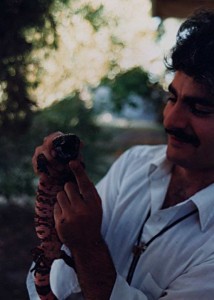
“As I was ready to go on to my first fishing trip, there were all these Cuban-Americans running down the docks with fistfuls of money asking to be taken to Havana to find their relatives. We left with eleven and came back with 200. I was on Walter Cronkite because I had my guitar on the boat,” said Cartsonis.
During his stint in Southern Florida, Cartsonis somehow found himself on a Naval base teaching juvenile delinquents. But true to form, the young man decided to show the kids how to make Steel Drums, which he’d learned from reading Pete Segger’s early 60s instructional field-guide, The Steel Drums of Kim Loy Wong.
“When I was younger, I subscribed to Sing Out (folk fan zine) and Pete Seeger published his address in it. So, years later, I wrote him a letter (about the drums) and he wrote back. It was so cool, he replied ‘There’s been a lot of development in steel drum technology, let us know how it worked out,”‘and even signed it with the little banjo in his signature,” Cartsonis fondly recalls.
But like most random occurrences in Cartsonis’ life, this semi-fan letter would only be the first of many dialogues with Seeger. When Cartsonis finally decided he was done (for the time being), sewing his wild oats, he would again encounter the Seeger family when he became roommates (and band mates) with Kim Seeger (Mike’s son) at Vassar College only a few years after the historically all girl’s school became co-ed. Yet, it wasn’t through Kim Seeger that Cartsonis would acclimate himself with the elder statesman, rather it was by chance one evening in Poughkeepsie, NY, that Cartsonis would find himself in the company of Papa Pete and his banjo, when he happened to walk into a nearby club the Founding Father of Folk frequented.
“He handed me his banjo, the one that says This Machine Surrounds Hate,” recalls Cartsonis of his experience playing an instrument he considers, the “holy-grail” of folk banjos.
If Cartsonis could cite someone as his mentor, it would likely be Seeger. Between his friendship with nephew Kim and this chance meeting with his idol, for years, Cartsonis wasn’t far from the family and to this day, he values their relationship, despite Seeger’s sometimes unreliable memory.
“He’s had lyme disease like four times. They live like the old hippies that they are. There was a period the last few times I saw him, where he asked me to remind him how we know each other, he said “I know you, I remember when your hair was black,” Cartsonis recalls lending his spot on impersonation of the elder Seeger.
“When I went back to see him at his birthday party at Madison square garden, he didn’t remember me. But when I saw him this year he did,” he explains.

Late 1983, Vassar Colleg in front of Ferry House… — (Left to Right) Peter Dianni, Norman Plankey, Kim Seeger, Neill MacColl, Calum MacColl, Matt Cartsonis
After a post-academia transitional period, where Cartsonis found himself gigging at various dives across the country, he would eventually leave upstate New York and make his way out to the Sin City, where he would form some of his most lasting musical kinships and finally settle down in a place that on the surface, couldn’t be further away from all that he’d known or believed in. Still, amidst a sea of image conscious industry types, Cartsonis was able to connect with some rather unlikely and diverse kindred spirits, most notably, Texas native, classic country purist and founder of Los Angeles’ famed Groundling Theatre, Gary Austin.
“Matt was the first person I’d met in Los Angeles who liked the same music as me,” recalls Austin of his longtime friend and partner in crime.
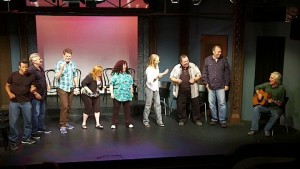
Matt Cartsonis (right) with Phil LaMarr, Sandy Helberg, Jamie Kaler, Kinna McInroe, Wenndy MacKenzie, Helen Hunt, Ron Wilson and Rob Watzke at the Gary Austin and Friends Live Show, from July 18, 2011.
But when Cartsonis moved to Southern California, on his 30th birthday on the advice of his movie producer sister, the last place he wanted to wind up was back in the bars he’d spent his youth frequenting. So, when he was given the opportunity to join Austin in bringing the world groundbreaking improvisational theatre, it came as a welcome and pleasant change of pace, that would allow him to hone in on his most natural of talents and to this day, is still one of his most enjoyable outlets.
“I knew that there was cool out here, but I didn’t know where to find it. It’s always been fun (improvising), I’ve always enjoyed tormenting my family with stuff like that. But, without a guitar I can’t do it, it’s too much thinking,” Cartsonis confesses.
Cartsonis, who teaches Song Improvisation with one of LA’s premier vocal coaches, Wennedy MacKenzie at Gary Austin Workshops, finds that music, rather than speech is his most organic mode of communication. Perhaps no better example occurred in 1993, when he found himself on stage with Emmylou Harris at the Roxy Theatre’s yearly Give Me Shelter benefit he was playing with Peter Himmelman.
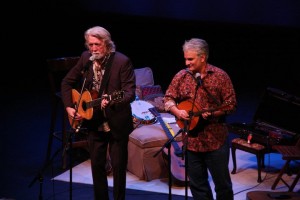
Cartsonis (right) with long time picking partner, Nitty Gritty Dirt Band founding member, John McEuen.
“This guy came out playing bass and I thought ‘That’s Daniel Lanois, that means Emmylou Harris isn’t far away,’ so I did some fishing and started playing Buck Owen’s “Crying Time,” and within three words, she started looking me in the eyes and harmonizing,” recalls Cartsonis.
This event that would also lead to Cartsonis reconnecting with Nitty Gritty Dirt Band founding member, John McEuen (who’d he’d met before in Arizona). But this time, when McEuen noticed Cartsonis’ mandolin, he said “let’s go pick,” and since that day, Cartsonis would find himself in the company of the Banjo playing legend and eventually on stage at Saturday Night Live with him and fellow funny-man picker, Steve Martin.
But perhaps the most touching story Cartsonis can tell, comes by way of his bond with Warren Zevon. Cartsonis’ experiences with his late friend, certainly lend evidence to a reality that isn’t necessarily in line with the image Zevon tried to create or public memory of the hell-raising anti-hero. He was, like anyone else, nothing more than human.
“Warren was just a man, he wasn’t a hero. He was a very scared guy who did remarkable stuff in his last moments,” said Cartsonis.
Although he isn’t willing to put Zevon on a pedestal or reveal the intimate details of their relationship, it is clear that Cartsonis cared deeply for his friend. But despite the intensive one year collaboration that came at the end of Zevon’s life, it isn’t something Cartsonis dwells on.
“It’s not something I go back to, but for some reason I was compelled to look at our old correspondence recently and I saw this email where Warren told me, “it’s a particularly aggressive form of cancer, don’t ask if it gets better. But if I’m going to go out, it’s not gonna be without good press baby,” and that was Warren,” said Cartsonis.
But before he came to know Warren Zevon, the man, he was a fan of his music. So, when the opportunity came up to play with him, it was one Cartsonis couldn’t pass up. Yet at the same time, his experiences reveal the truth in his opinion.
“I enjoyed playing with him (Zevon), hugely. I played electric guitar and fiddle. Some mandolin and banjo sometimes. That was with the band. Then we played duo stuff. Didn’t do a lot of gigs but did a lot of playing together,” said Cartsonis.
At the time Cartsonis came along into Zevon’s life, it seems, unfortunately, to have been a bit late in the game. Zevon, who notoriously struggled to find his place in the Music business, was naive when it came to understanding his audience and finding his ‘people.’ But thanks to Cartsonis, he was able to enjoy some of his final moments among his welcoming peers and find a sense of belonging before his untimely death at the age of 56. But in the true spirit of Zevon, it seems such discoveries came with some objection and reluctance.
“Our partnership happened because at the time, he didn’t have much of a career. He was always a cult hero but didn’t have big gigs. Then I told him that the folk scene was where his people were and finally he agreed to play up in Calgary,” said Cartsonis.
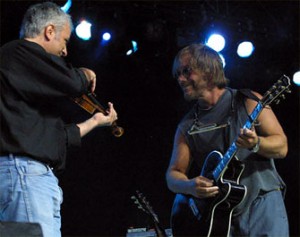
The festival, which was filled with workshop stages, found Zevon out of his comfort zone. So much so, in fact, an increasingly eccentric Zevon decided to leave the festival, when he was simply asked, like most performers, to head a Workshop stage. Luckily for Cartsonis, it turns out Zevon’s departure from the event came as yet another opportunity for him to play with some of his heroes (Nick Lowe, Terry Allen, Robyn Hitchcock) and is an experience that is one of his fondest career memories.
“Robyn started buying me wine, then Nick started buying me wine. We were all trashed and played together. It was awesome,” said Cartsonis, who would eventually get Zevon over his paranoia and back to the folk festival stages.
But as history would have it, only a year later, in 2003, Zevon would find himself saying goodbye to the world. In his final chaotic days, he decided to take a limo around Los Angeles, in an effort to close the final chapter on his life and bid farewell to his friends. Of course, his last unconventional encounter with Cartsonis, was appropriately in the spirit of the “weird” (as Zevon co-conspirator, the late Gonzo journalist, Hunter S. Thompson called it) he so passionately embraced.
TJ editor, Courtney Sudbrink scratches the surface on a remarkable life, outside a Song Improv workshop in North Hollywood.
“Warren came by my house one night to say goodbye. I thought at the time he was coming to pick up a video tape. He did that too,” Cartsonis remembers.
Though he is most at ease playing along with others, to his credit, Cartsonis’ accomplishments in the world of film and television scoring are extensive. Despite not really fitting in with all that Hollywood represents, he has certainly added remarkable music to some of the industry’s rootsier projects, such as his collaboration with long time partner, and former Brian Wilson lyricist, Van Dyke Parks for the AMC Award winning, Broken Trail. A Sundance Composer’s Fellow, Cartsonis’ most recent effort with Parks, found him paying respects to the man whose music helped shaped his youth, that is with “Note of Hope,” his contribution to the Hank Williams: Lost Notebooks style, Woody Guthrie project of the same name.
But Cartsonis isn’t one to brag about his own accomplishments, a condition that truly makes him standout in this town. Despite having the same comedic and musical chops as artists like Arlo Guthrie, Randy Newman and John Prine, Cartsonis simply isn’t comfortable in the limelight. And though songs like his original, moody yet witty, “Yuletide in The Doublewide,” exemplify his satirical ability, he is far more comfortable in the role of one of Sin City’s most fascinating and influential sidemen. Because, at the core, Matt Cartsonis ain’t nothin’ but a picker who loves to add his take on whatever is thrown at him.
12 Yuletide In The Doublewide by Matt Cartsonis
For more information on Matt Cartsonis, visit his website: http://www.mattcartsonis.com and be sure to catch him on December 12, performing at the Groundling Theatre with Gary Austin.
Latest posts by TJ Staff (see all)
- Song premier: Brooke Graham – “Merryachi Christmas” - October 31, 2022
- Sean Devine’s Here For It All - September 7, 2021
- Video Premier: “No One Gets Pulled Over on Christmas Eve” (The Smoking Flowers) and “Santa Claus is Dead” (Dee Oh Gee) - December 22, 2020


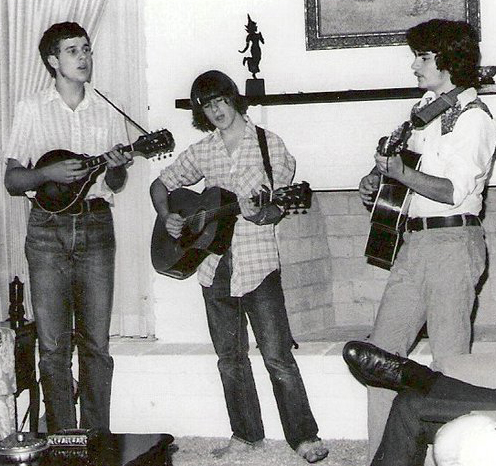
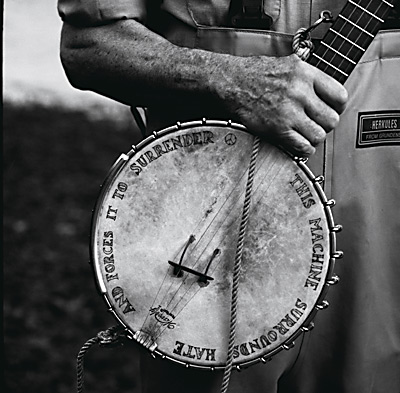
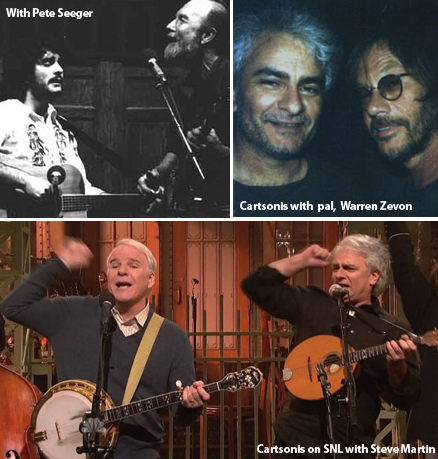
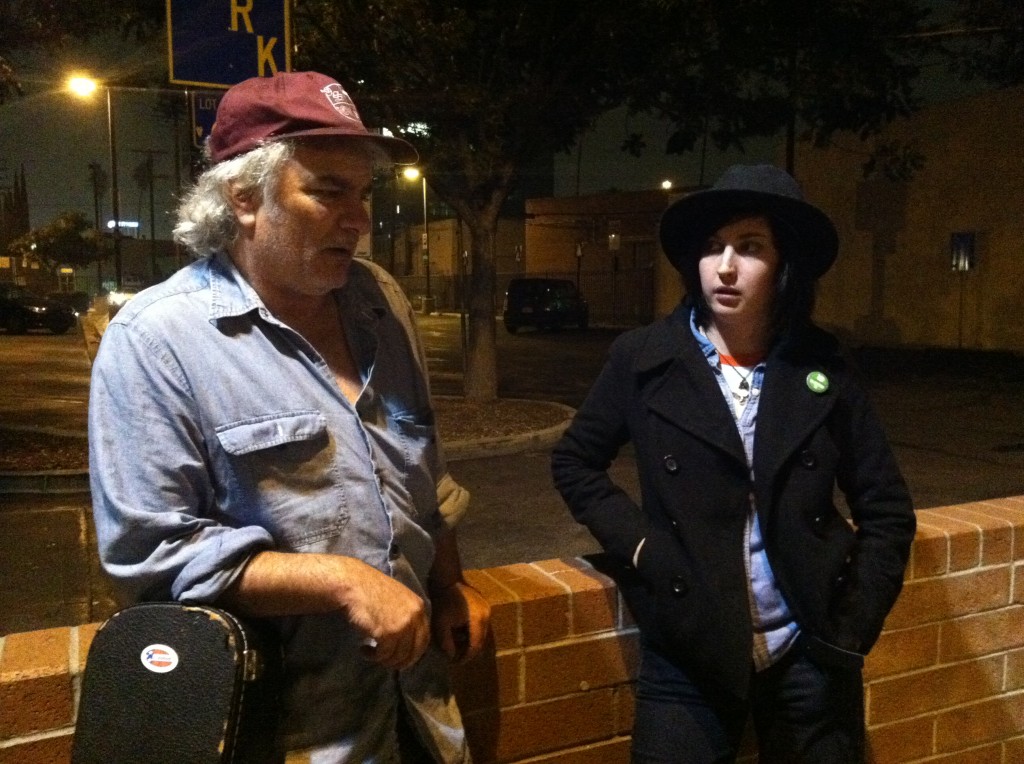
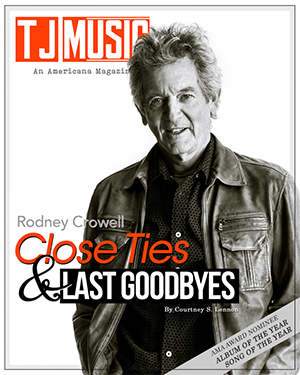
Unsung East Coast exploit: whilst dining in New Haven, CT, Matt was given a T-shirt from Mamoun’s Felafel — later, he sent a jpeg of himself wearing it onstage (pic allegedly snapped by Warren Z). I forwarded the file to Suleiman at Mamoun’s who printed it out and stuck it on the wall in the kitchen, much to the puzzlement of the Mamoun family (which includes pop crooner Michael Bolton, by the by)
I heard Matt play at Vassar and sang with him offstage once or twice. You were a generous soul, Matt! You made everyone else glad to hear you or play along. Congratulations on continuing to share your gift!
Brilliant article and works.
Pingback: Sounds of Sin City Giveaway
Great article. Matt is an amazing artist and human. So good to see the spotlight on him. He deserves it.
Pingback: Don’t Let the Sunshine Fool Ya: The Sin City Sings the Songs of Guy Clark